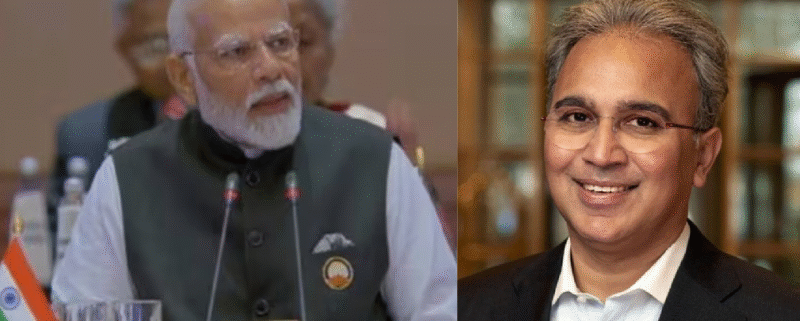Rajiv Memani Predicts 6.4–6.7% Growth for Indian Economy in FY26 — A Major Financial News Update from CII
New Delhi | July 5, 2025 —
In a major financial news development that sets the tone for the fiscal year ahead, Rajiv Memani, the newly appointed President of the Confederation of Indian Industry (CII), has projected that India’s economy will grow at a robust rate of 6.4% to 6.7% in FY2025-26. This bold yet data-backed forecast underscores the country’s sustained momentum as the fastest-growing major economy in the world.
Delivering his first address as CII President, Memani presented the projection during a high-profile press briefing, citing strong domestic demand, an improving macroeconomic environment, and structural tailwinds as primary contributors. The estimate was generated through CII’s proprietary GDP Growth Model, which incorporates dynamic economic indicators and policy trends across sectors.
“We expect real GDP growth in the 6.4%–6.7% range for FY26,” Rajiv Memani stated confidently. “India’s economic engine continues to be powered by robust domestic consumption, improving liquidity, and sound monetary policies.”
This announcement is among the most significant pieces of financial news emerging from India in recent months and signals renewed confidence in the nation’s post-pandemic recovery and structural resilience.
Top Highlights from Rajiv Memani’s Financial Outlook: A Closer Look at Growth Drivers
Memani’s comprehensive financial news briefing highlighted a mix of short-term catalysts and long-term enablers that are expected to contribute to India’s economic expansion:
1. Favorable Monsoon Outlook
A strong monsoon forecast for 2025 is likely to boost agricultural productivity, especially in rural India, where farming still forms the backbone of economic activity. Better yields will enhance rural income, revive consumption, and indirectly benefit sectors such as FMCG, retail, and two-wheeler sales.
2. Liquidity Enhancement Through CRR Cut
The Reserve Bank of India’s decision to reduce the Cash Reserve Ratio (CRR) is another major development, injecting additional liquidity into the financial system. Banks will have more room to lend, and credit growth — a key metric for economic health — is expected to accelerate.
3. Interest Rate Moderation
Inflation in India has gradually moderated, paving the way for potential rate cuts by the central bank. Lower borrowing costs can unlock capital investments from both corporations and consumers, stimulating demand and supply across multiple sectors.
“Together, these factors create a favorable environment for a sustained growth cycle, making this one of the most optimistic financial news updates of the year,” Memani added.
External Risks Still Cast a Shadow Over India’s Growth Trajectory
Despite the positive outlook, Rajiv Memani issued a note of caution, pointing to persistent geopolitical uncertainty and international financial market volatility as key downside risks.
Key External Challenges Include:
-
Rising geopolitical tensions in the Middle East and Eastern Europe
-
Potential oil price shocks, which could disrupt India’s import bill and inflation
-
Unpredictable monetary policy moves by the U.S. Federal Reserve
-
Currency fluctuations and global capital outflows
“While our fundamentals are strong, external shocks could ripple through our economy. It’s critical we stay adaptive and resilient,” said Memani, emphasizing the importance of monitoring global financial news trends regularly.
Sectoral Outlook: Financial News You Can Use
Although Rajiv Memani did not release sector-wise growth figures, the CII’s analysis identifies several key industries likely to fuel India’s GDP expansion:
-
🏗️ Infrastructure & Construction: Government-led capital expenditure continues to drive massive infrastructure development, boosting allied industries like cement, steel, and engineering.
-
🛍️ Retail, FMCG & Consumer Durables: As consumer sentiment improves post-inflation, rural and urban spending is expected to rise.
-
💻 IT & Digital Services: India’s software exports and domestic digital transformation initiatives are likely to maintain momentum.
-
🏦 Financial Services: Increased credit demand, expanding fintech ecosystems, and capital market participation will play a critical role in driving financial inclusion.
This breakdown offers actionable financial news insights for investors, business strategists, and market analysts tracking India’s economic evolution.
Rajiv Memani’s Strategic Policy Vision for FY26
Memani also presented a blueprint of forward-looking policy recommendations, aimed at sustaining and deepening India’s economic momentum:
Key Policy Priorities:
-
Stimulating Private Investment: Through regulatory simplification, tax relief, and infrastructure acceleration.
-
Empowering MSMEs: By expanding access to affordable credit, digitization support, and market linkages.
-
Green Financing & Sustainability: Encouraging eco-friendly business models through incentives and ESG-linked investments.
-
Skilling the Workforce: To prepare India’s young population for emerging sectors like AI, green tech, and data economy.
These priorities signal a shift from short-term recovery to long-term transformation — a central theme of this financial news briefing.
Final Word: India’s Economic Narrative Continues to Inspire Financial News Headlines
This latest growth projection by CII under Rajiv Memani’s leadership comes at a pivotal moment. With global investors reevaluating emerging markets and supply chains being reoriented toward India, the country is well-positioned to seize a generational opportunity.
“This is not just a growth forecast, it’s a confidence signal to the world,” Memani concluded. “India’s story is evolving — and we must ensure that every financial news headline reflects that transformation with responsibility, purpose, and clarity.”
